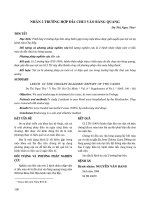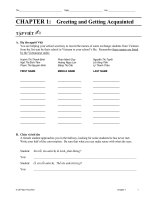Tài liệu Chapter 2 docx
Bạn đang xem bản rút gọn của tài liệu. Xem và tải ngay bản đầy đủ của tài liệu tại đây (525.65 KB, 53 trang )
© 2008 Pearson Prentice Hall, Electronic Commerce 2008, Efraim Turban, et al.
Chapter 2
E-Marketplaces: Structures,
Mechanisms, Economics, and
Impacts
2-2
Learning Objectives
1. Define e-marketplaces and list their
components.
2. List the major types of e-marketplaces and
describe their features.
3. Describe the various types of EC
intermediaries and their roles.
4. Describe electronic catalogs, shopping carts,
and search engines.
5. Describe the major types of auctions and list
their characteristics.
2-3
Learning Objectives
6. Discuss the benefits, limitations, and impacts
of auctions.
7. Describe bartering and negotiating online.
8. Define m-commerce and explain its role as a
market mechanism.
9. Discuss competition in the digital economy.
10.Describe the impact of e-marketplaces on
organizations and industries.
2-4
E-Marketplaces
e-marketplace
An online market, usually B2B, in which
buyers and sellers exchange goods or
services; the three types of
e-marketplaces are private, public, and
consortia
2-5
E-Marketplaces
2-6
E-Marketplaces
marketspace
A marketplace in which sellers and buyers
exchange goods and services for money
(or for other goods and services) but do so
electronically
2-7
E-Marketplaces
Customers
Sellers
Products and services
digital products
Goods that can be
transformed to digital
format and delivered
over the Internet
Infrastructure
Front end
Back end
Intermediaries
Third parties that
operates between
sellers and buyers
Other business partners
Support services
E-Marketplace Components and Participants
2-8
E-Marketplaces
front end
The portion of an e-seller’s business
processes through which customers interact,
including the seller’s portal, electronic
catalogs, a shopping cart, a search engine,
and a payment gateway
back end
The activities that support online order
fulfillment, inventory management, purchasing
from suppliers, payment processing,
packaging, and delivery
2-9
Types of E-Marketplaces:
From Storefronts to Portals
Electronic Storefronts
storefront
A single company’s Web site where products or services are
sold
e-mall (online mall)
An online shopping center where many online stores are
located
Visualization and virtual realty in shopping malls
2-10
Types of E-Marketplaces:
From Storefronts to Portals
Types of Stores and Malls
General stores/malls
Specialized stores/malls
Regional versus global stores
Pure-play online organizations versus click-and-mortar stores
2-11
Types of E-Marketplaces:
From Storefronts to Portals
2-12
Types of E-Marketplaces:
From Storefronts to Portals
Types of E-Marketplaces
private e-marketplaces
Online markets owned by a single company; may
be either sell-side and/or buy-side e-marketplaces
sell-side e-marketplace
A private e-marketplace in which one company sells
either standard and/or customized products to
qualified companies
buy-side e-marketplace
A private e-marketplace in which one company
makes purchases from invited suppliers
2-13
Types of E-Marketplaces:
From Storefronts to Portals
Types of E-Marketplaces
public e-marketplaces
B2B marketplaces, usually owned and/or managed by an
independent third party, that include many sellers and many
buyers; also known as exchanges
2-14
Types of E-Marketplaces:
From Storefronts to Portals
information portal
A single point of
access through a
Web browser to
business information
inside and/or outside
an organization
Types of Portals
Commercial (public)
Corporate
Publishing
Personal
Mobile
Voice
Knowledge
2-15
Types of E-Marketplaces:
From Storefronts to Portals
2-16
Transactions, Intermediation,
and Process in E-Commerce
Sellers, Buyers, and Transactions
A seller (retailer, wholesaler, or manufacturer) sells to
customers
The seller buys from suppliers: either raw material (as a
manufacturer) or finished goods (as a retailer)
2-17
Transactions, Intermediation,
and Process in E-Commerce
2-18
Transactions, Intermediation,
and Process in E-Commerce
The Roles and Value of Intermediaries in
E-marketplaces
infomediaries
Electronic intermediaries that provide and/or control
information flow in cyberspace, often aggregating information
and selling it to others
2-19
Transactions, Intermediation,
and Process in E-Commerce
A broker is a company that facilitates transactions between
buyers and sellers
Types of brokers
Buy/sell fulfillment
Virtual mall
Metamediary
Bounty
Search agent
Shopping facilitator
2-20
Transactions, Intermediation,
and Process in E-Commerce
Intermediaries can address the following
five important limitations of direct
interaction:
1. Search costs
2. Lack of privacy
3. Incomplete information
4. Contract risk
5. Pricing inefficiencies
2-21
Transactions, Intermediation,
and Process in E-Commerce
e-distributor
An e-commerce intermediary that
connects manufacturers with business
buyers (customers) by aggregating the
catalogs of many manufacturers in one
place—the intermediary’s Web site
2-22
Transactions, Intermediation,
and Process in E-Commerce
disintermediation
Elimination of intermediaries between
sellers and buyers
reintermediation
Establishment of new intermediary roles
for traditional intermediaries that have
been disintermediated, or for newcomers
2-23
Transactions, Intermediation,
and Process in E-Commerce
2-24
Electronic Catalogs
and Other Market Mechanisms
electronic catalogs
The presentation of product information in an
electronic form; the backbone of most e-
selling sites
Three dimensions of electronic catalogs:
1. The dynamics of the information presentation
2. The degree of customization
3. Integration with business processes
2-25
Electronic Catalogs
and Other Market Mechanisms









